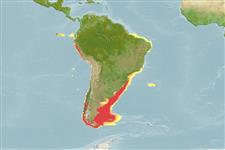Common names from other countries
Environment: milieu / climate zone / depth range / distribution range
Écologie
Bathydémersal. Subtropical; 0°N - 90°S, 180°W - 180°E
Eastern Pacific and Southwest Atlantic: Arctocephalus australis gracilis: Peru, southern Brazil, Uruguay, Argentina, Chile (Ref. 1394, 1522); vagrant to Colombia and Juan Fernandez Islands (Ref. 1522); Arctocephalus australis australis: Falkland Islands (Ref. 1522). Tropical to temperate climates.
Length at first maturity / Taille / Poids / Âge
Maturity: Lm ? range ? - ? cm Max length : 190 cm TL mâle / non sexé; (Ref. 1394); 140 cm TL (female); poids max. publié: 200.0 kg (Ref. 1394); poids max. publié: 200.0 kg
Inhabits primarily coastal, continental shelf and slope waters; and there are records from more than 600 km offshore. Feeds on small schooling fish and invertebrates such as cephalopods, crustaceans and gastropods. Found primarily coastal, continental shelf and slope waters; there are records from more than 600 km offshore. Feeds on small schooling fish and invertebrates such as cephalopods, crustaceans and gastropods (Ref. 1394).
Life cycle and mating behavior
Maturité | Reproduction | Frai | Œufs | Fécondité | Larves
Pups are born in dense breeding colonies. Perinatal attendance averages one week, then mothers forage offshore several days at a time. Upon arrival from sea, mother and pup reunites using vocalization signals and olfactory cues, i.e., naso-nasal contact. Lactation lasts at least 12 months.
Jefferson, T.A., S. Leatherwood and M.A. Webber. 1993. (Ref. 1394)
Statut dans la liste rouge de l'IUCN (Ref. 130435)
statut CITES (Ref. 108899)
Utilisations par l'homme
Pêcheries: commercial
FAO - pêcheries: landings, species profile | FishSource | Sea Around Us
Outils
Sources Internet
Estimates based on models
Preferred temperature
(Ref.
115969): 5.6 - 15.5, mean 9.2 (based on 1202 cells).
Résilience
Milieu, temps minimum de doublement de population : 1,4 à 4,4 années (K=0.3).
Vulnérabilité
Moderate to high vulnerability (52 of 100).
Catégorie de prix
Unknown.
